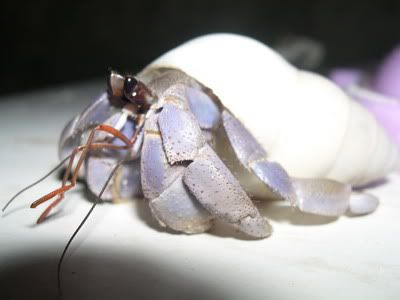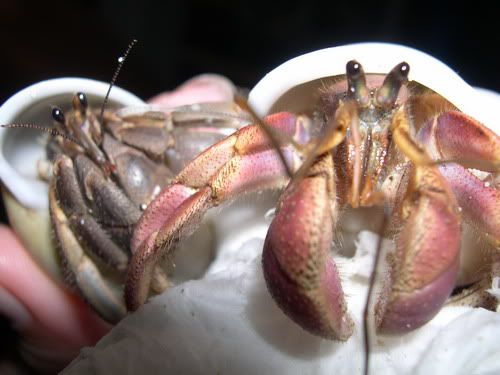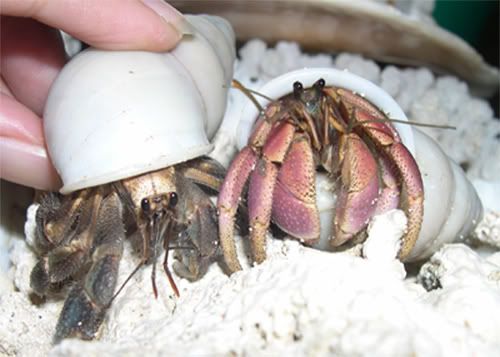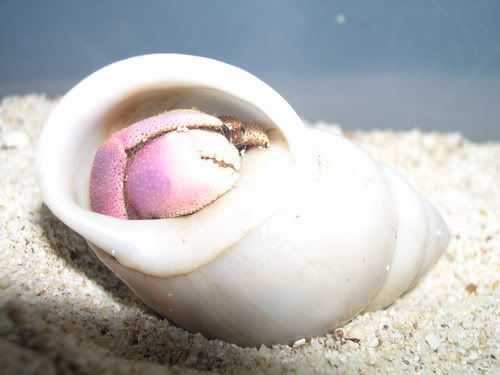Sinistral Land Hermit Crab Discussion (Pictures) LOTS!
-
Guest
I can try sending the pix to a coenobita expert at the Smithsonian. But he doesn't like getting ID requests very much. Last time he told me that he needed a crab IN HAND in order to identify it properly.
But since it has a backwards curl to its tail -- or so it seems -- maybe he'll be intrigued.
Lemme see if he's feeling cooperative. I'll get back as soon as I hear anything.
But since it has a backwards curl to its tail -- or so it seems -- maybe he'll be intrigued.
Lemme see if he's feeling cooperative. I'll get back as soon as I hear anything.
-
Gorthaur
You all seem to be forgetting that any species can wear a left-handed shell. When baby crabs first come onto land, they take whatever shell they can find, and their abdomen grows to fit it. It also seems logical to assume that whatever claw guarded the opening of the shell would grow larger, i.e. a large claw does not fit inside the shell with the small claw on the outside. I would also say that this growth pattern has no relation to the species. Think about it.
My guess is that these crabs are Cavs. They don't seem to have any features that do not make them Cavs.
My guess is that these crabs are Cavs. They don't seem to have any features that do not make them Cavs.
-
Mokulele_Hawai'i
Topic author - Posts: 142
- Joined: Sat Mar 05, 2005 3:31 pm
- Location: Jakarta, Indonesia
- Contact:
Thank you for the replies & inputs guys ...
I'm still in doubt whether those sinistrals are Cavs.
Please compare the eyes with mars' purple crab and my crab below:
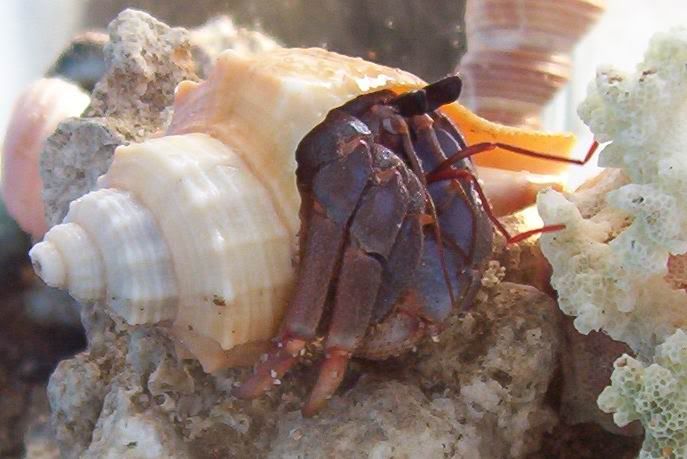
Mine & mars' crab have strongly compressed eyes !
Or (on the other hand), my sinistrals are Cavs indeed, while the crab above is anoother species ( since the features resemble C.violascens - if there are ruggies & cavs in Japan, why cannot C.violascens inhabits Southeast Asian archipelagos )?
I'm still in doubt whether those sinistrals are Cavs.
Please compare the eyes with mars' purple crab and my crab below:

Mine & mars' crab have strongly compressed eyes !
Or (on the other hand), my sinistrals are Cavs indeed, while the crab above is anoother species ( since the features resemble C.violascens - if there are ruggies & cavs in Japan, why cannot C.violascens inhabits Southeast Asian archipelagos )?
Hermit crab lover since 1981
Founder of "Blueberry land hermit crab" - common name for Coenobita purpureus, and "Zebra Sunset land hermit crab" for a new subspecies of Coenobita violascens
Founder of "Blueberry land hermit crab" - common name for Coenobita purpureus, and "Zebra Sunset land hermit crab" for a new subspecies of Coenobita violascens
-
Guest
As I thought; they're cavipes, most likely. Here's Dr. Tudge's answer:
Helpful, I hope!Kerie,
As you well note it is very difficult to identify LHC's from pictures,
especially when they are in vivo and still in their shells. For positive
ID you need to get them out of the shell and check them over with a hand
lens or microscope.
I can fully believe that these are C. cavipes that have simply took up
residence in sinistral shells. Sinistral gastropods are rare in the
environment and so most hermits utilize and are built for dextral
shells. Marine hermits in sinistral shells have been recorded before
from Japan and the Caribbean (Imafuku and Turra, respectively: I think
as I do not have the papers handy?). If you need the references I can
get them to you next week.
So, I can believe that normally dextrally coiled LHC's are perfectly
flexible enough to take up residence in a sinistral shell, especially if
competition is fierce for shells or if dealers hoping to get more money
for these "unusual" hermits, force them into sinistral shells.
I can't tell from the photos which claw is the larger, sometimes they
are almost subequal anyway. One has to be careful also that images or
negs. have not been inadvertently reversed.
If it looks like a C. cavipes then it probably is one. To approach it
from a scientific standpoint I would want to know the following:
1. Where exactly they came from? What species naturally occur there?
2. Did they arrive from the wild in sinistral shells?
3. Does this species of sinistral shell occur naturally in their
environment?
4. Can they switch easily from sinistral to dextral shells?
5. Do they show a preference for sinistral versus dextral shells?
6. When out of the shell do their abdomens curve the sinistral way all
the time?
7. Are their internal organs displaced sinistrally, in opposition to the
dextrally coiled and displaced organs in most hermit crabs? For example,
the paired gonads inside a hermit crabs abdomen are smaller on the
inside than the outside of the curve.
Answers to these questions will go a long way to finding out if we have
a sinistrally adapted population of C. cavipes (genetically distinct?)
or a new species (which I doubt). Or, do we just have plasticity in the
ability of (some?) LHC's to accommodate their flexible? bodies into any
available structure (sinistral, dextral or whatever). In the latter
category I have seen pictures of LHC's in bottle caps, bottle mouths,
and other symmetrically straight houses.
If you can get some more information about these aspects of the
particular crabs you have it might help answer your question(s). When
these "unusual" LHC's eventually die, pickle them in 70% alcohol and
send them to me at the Smithsonian and I will give you a definitive
identification for them.
Cheers Chris
-
Guest
Mars, I think that crab might actually be a c. violascens.mars wrote:
The C. cavipes I found there (also left-handed) relatively has bigger and more oval eye shape, like this,
http://www.hermitcrabparadise.com/photo ... m=36&pos=1
The eyes are too big to be cavipe.
-
Guest
-
Guest
[quote="Julia_Crab]
Mars, I think that crab might actually be a c. violascens.
http://www.hermitcrabparadise.com/photo ... m=36&pos=1
The eyes are too big to be cavipe.[/quote]
Julia, your efforts are much appreciated. Thank you very much.
So that my purple crab above is a C.violascens. I’m surprise and happy to hear that .
.
Previously I think it was a C. cavipes - I once asked (in July 2005) about the ID of my other purple crab with the similar shape of eyes, chelipeds, joint leg, antennae and at that time, the answer is that my purple crabs are C. cavipes.
Mars, I think that crab might actually be a c. violascens.
http://www.hermitcrabparadise.com/photo ... m=36&pos=1
The eyes are too big to be cavipe.[/quote]
Julia, your efforts are much appreciated. Thank you very much.
So that my purple crab above is a C.violascens. I’m surprise and happy to hear that
Previously I think it was a C. cavipes - I once asked (in July 2005) about the ID of my other purple crab with the similar shape of eyes, chelipeds, joint leg, antennae and at that time, the answer is that my purple crabs are C. cavipes.
-
Guest
-
Guest
-
Guest
The eyestalks look very compressus to me, too.amnell71 wrote:Is it just me, or does the c. violascens look like a cross between a c. rugosus and a c. brevimanus, with just a hint of cavipes thrown in?
This is why Dr. Tudge doesn't like to ID crabs by pictures. Because sometimes it really is difficult to tell without inspecting characteristics with a scope of some kind.
-
Guest
-
Mokulele_Hawai'i
Topic author - Posts: 142
- Joined: Sat Mar 05, 2005 3:31 pm
- Location: Jakarta, Indonesia
- Contact:
I also believe that all LHC may adapt themselves into sinistral shells.I can fully believe that these are C. cavipes that have simply took up
residence in sinistral shells. Sinistral gastropods are rare in the
environment and so most hermits utilize and are built for dextral
shells.
mars, could you please display the sinistral C.brevimanus you found on Pulau Bintang in this forum ?
That C.brevimanus has same-sized claws. Please also see the thread "Gigantic Indos" - I posted a picture of my new Indo that might have been using junk things, such as glass bottles, plastic bottle lid, or softdrink cans for a long time and such habit might have led his left & right pincers grow to relatively same-size ( the left pincer is not extremely bigger than the right one, like "normal" indos who inhabit dextral shell).
Bintang Coral Islet, Java Sea (north of the City of Jakarta).So, I can believe that normally dextrally coiled LHC's are perfectly
flexible enough to take up residence in a sinistral shell, especially if
competition is fierce for shells or if dealers hoping to get more money
for these "unusual" hermits, force them into sinistral shells.
I can't tell from the photos which claw is the larger, sometimes they
are almost subequal anyway. One has to be careful also that images or
negs. have not been inadvertently reversed.
If it looks like a C. cavipes then it probably is one. To approach it
from a scientific standpoint I would want to know the following:
1. Where exactly they came from? What species naturally occur there?
mars reported that she had met C.bevimanus in gigantic sizes, abundant C.rugosus, occasional purple LHC w/ compressed eyestalks and red antennae (C.cavipes or C.violascens?), as well as abundant LHC with such left-handed Amphidromus outfit.
Yes, they are. And such sinistral Amphidromus are locally abundant in some areas.2. Did they arrive from the wild in sinistral shells?
3. Does this species of sinistral shell occur naturally in their
environment?
Yes, even one C.brevimanus using sinistral shell was also found.
They have never shown any attempt to try dextral shells I offered.4. Can they switch easily from sinistral to dextral shells?
I think so ...
5. Do they show a preference for sinistral versus dextral shells?
I'm still not sure about this, but one of them is surely female and I saw that the6. When out of the shell do their abdomens curve the sinistral way all
the time?
7. Are their internal organs displaced sinistrally, in opposition to the
dextrally coiled and displaced organs in most hermit crabs? For example,
the paired gonads inside a hermit crabs abdomen are smaller on the
inside than the outside of the curve.
pleopods are located on the left-hand side of her abdomen.
Thank you very much, Chris ... you're very helpful. I will try my best to send you one sample when any of them dies. Hopefully the result will be available to be included in my book beforeAnswers to these questions will go a long way to finding out if we have
a sinistrally adapted population of C. cavipes (genetically distinct?)
or a new species (which I doubt). Or, do we just have plasticity in the
ability of (some?) LHC's to accommodate their flexible? bodies into any
available structure (sinistral, dextral or whatever). In the latter
category I have seen pictures of LHC's in bottle caps, bottle mouths,
and other symmetrically straight houses.
If you can get some more information about these aspects of the
particular crabs you have it might help answer your question(s). When
these "unusual" LHC's eventually die, pickle them in 70% alcohol and
send them to me at the Smithsonian and I will give you a definitive
identification for them.
Cheers Chris
I publish the first hermit crab care book in Indonesian language.
By the way, I need one more opinion from you, Chris:
These two crabs below (from my collection) have similar eyestalks and leg segment proportions, except for the color: one in the Trochus niloticus is brownish-black, while the other one is fire red. In my opinion, if those two "normal" LHC are C.cavipes, so are the sinitral ones.


But ... has the purple-legged LHC (with occasional red, orange, or brown tint), fire-red eyestalks, and fully compressed eyes actually been misidentified as C.cavipes? Please take a look at mars' purple crab above and this bluish-brown & orange crab:
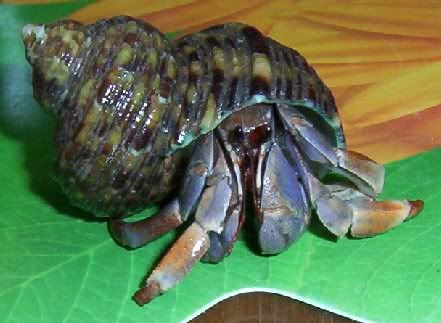
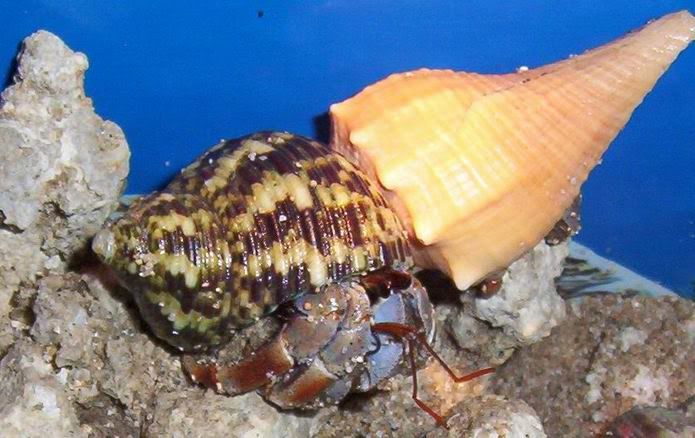
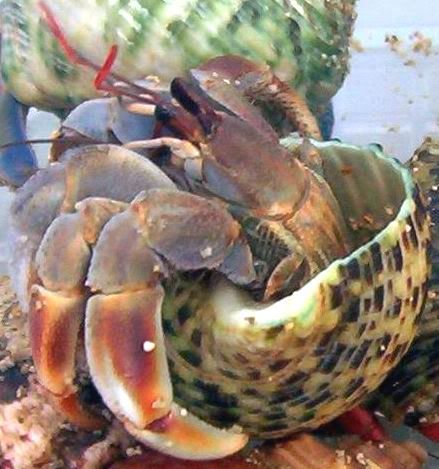
The features (incl. how the leg segmentation is proportioned) are more similar to C.violascens - that are native to Ryukyu Islands (Okinawa).
Or may bigger-built cavs commonly has more compressed eyes than the small ones ?
Hermit crab lover since 1981
Founder of "Blueberry land hermit crab" - common name for Coenobita purpureus, and "Zebra Sunset land hermit crab" for a new subspecies of Coenobita violascens
Founder of "Blueberry land hermit crab" - common name for Coenobita purpureus, and "Zebra Sunset land hermit crab" for a new subspecies of Coenobita violascens
-
Guest
-
Guest
